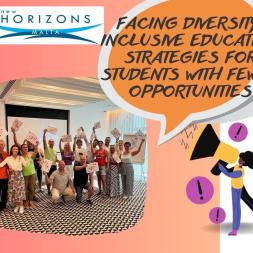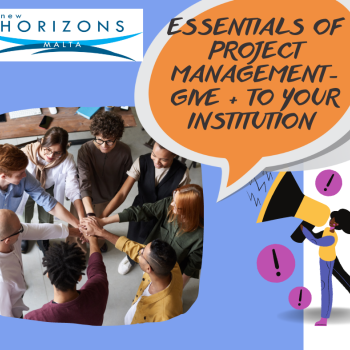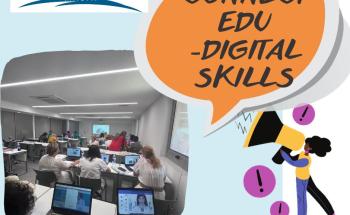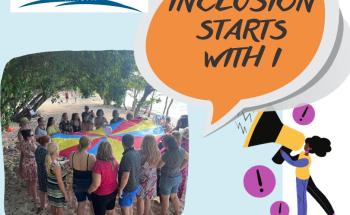
Facing Diversity: Inclusive education strategies for students with fewer opportunities
The aim of the training course is to empower teachers with skills and knowledge about access of students with fewer opportunities to formal and non-formal education, transnational mobility and participation, active citizenship, empowerment and inclusion in school and society and also strengthening the knowledge, skills and behaviors' needed to fully accept, support and promote the differences
Description
1 .INTERCULTURAL SETTINGS. Connection between culture and inclusion. Education For All. A global commitment. Multicultural or intercultural education. Show me your class and I will tell you who you are
2 INTRODUCTION TO INCLUSION. A clear, basic understanding of exclusion and inclusion. Principles of inclusive education. Aims and objectives of inclusive education. What means a teacher as inclusive promoter?
3. FEWER OPPORTUNITIES: legal framework. learners characteristics, identification, definitions, etiology, developmental consequences, interventions and prevention; Segregation, integration, inclusion: Inclusive Education Versus Special Education debate
4. INCLUSIVE EDUCATION: The research-basis for inclusive education. Need and importance. The basic elements of inclusive education; Reforms in curriculum. Creating an inclusive learning environment: how to deal with Stereotype threat, Pygmalion effect, Acculturation theory.
5.THE VALUE OF INCLUSIVE EDUCATION: The importance of inclusive education; The basic elements of inclusive education; The support of inclusive education; Social theatre, human library and improvisation as educational tools
6. Different ways in which INCLUSIVE EDUCATIONAL PRACTICES build a school's capacity to educate all learners effectively: Coaching models that increase students’ engagement.
7. STRATEGIES TO IMPROVE INCLUSIVE EDUCATION. How to foster students’ inclusion, tolerance and intercultural awareness through non-formal, informal and experiential learning activities. Non formal education tools aimed at social inclusion. Designing lessons and activities to support increasing diversity in contemporary classrooms Strategies to involve in school activities students in risk of exclusion.
8. TECHNIQUES TO SUPPORT SOCIAL INCLUSION. Conflict in classroom. Management styles of conflict.
Learning objectives
By the end of the course, each participant should be able to:
-to solve inclusion issues in multicultural classes
-to have a clear understanding of exclusion and inclusion
-to find solutions and take measures to avoid exclusion of young people with fewer opportunities
-to make inclusion a priority in their work
-to learn strategies for students with fewer opportunities so as to give access them to formal and non-formal education for empowerment and inclusion in school and society
-to raise motivation and interest work with disadvantaged students with fewer opportunities
-to plan for and design inclusive education environments for learning.
-to develop individual learning plans based on whole-school curriculum planning.
-to outline strategies for developing professional working relationships within this group.
-to select and use relevant curriculum and support resources
-to learn new non-formal education activities and techniques in order to better integrate of all students in the classroom
- to find strategies based on a very good overview and practical experience of tools through individual work, working groups and collective work regarding social inclusion
- to use new mediation and negotiation tools in the fight against exclusion of students with fewer opportunities
-to exchange practices and experiences on various aspects and perceptions of marginalization and inclusion.
Methodology & assessment
Certification details
At the end of the course, each participant will be awarded with the Europass Mobility Certificate, together with a descriptive certificate of attendance ( on the certificate will be specified the title of the course, name of the participant project, national reference number, numbers of hours, course dates and location). after participants enrollment, we provide also the learning agreement and the interinstitutional agreement. PREPARATION AND FOLLOW UP BEFORE:Every participant will have to fill a questionnaire which helps the trainers to customize the course to better fit their needs. Attendants will get instructions and material which will help them to be prepared for the courses needs. AFTER: The participants will get material which includes information about all the areas covered at the course, lesson plans , all the produced outcomes of the course, useful links and more. ON THE LAST DAY OF THE COURSE THE PARTICIPANTS WILL HAVE THE OPPORTUNITY TO CREATE A DRAFT OF FUTURE ERAMUS SMALL SCALE PROJECT AND DESIGN SUPPORT WILL BE GIVEN
Additional information
-
Language:English
-
Target audience ISCED:Early childhood education (ISCED 0)Lower secondary education (ISCED 2)Post-secondary non-tertiary education (ISCED 4)
-
Target audience type:TeacherHead Teacher / PrincipalPedagogical Adviser
-
Learning time:25 hours or more
Upcoming sessions
Past sessions
More courses by this organiser

ESSENTIALS OF PROJECT MANAGEMENT- GIVE PLUS TO YOUR INSTITUTION WITH QUALITATIVE STANDARDS OF PMI

CONNECTEDU: INFORMATION AND COMMUNICATION TECHNOLOGIES (ICT) FOR NOWADAYS CLASSES


